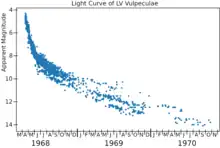 | |
| Observation data Epoch J2000 Equinox J2000 | |
|---|---|
| Constellation | Vulpecula |
| Right ascension | 19h 48m 00.437s[1] |
| Declination | 27° 10′ 17.36″[1] |
| Apparent magnitude (V) | 4.79[2] - 16.9[3] |
| Characteristics | |
| Variable type | Classical Nova |
| Other designations | |
| Database references | |
| SIMBAD | data |

LV Vulpeculae, also known as Nova Vulpeculae 1968 no. 1, was the first of two novae in the constellation of Vulpecula which erupted in 1968. It was discovered by George Alcock who observed it from the back garden of his home in Farcet, England, on the morning of 15 April 1968. The next night it was independently discovered by Midtskoven in Norway.[5][6] It reached a peak apparent magnitude of 4.79 on 17 April 1968.[2] It was visible to the naked eye at the same time HR Delphini (also discovered by George Alcock) was a naked eye object, and the two novae were less than 15 degrees apart on the sky.
Before its eruption, LV Vulpeculae was a magnitude 16.2 object.[7] It is classified as a "fast nova", meaning its brightness declined by more than 3 magnitudes in less than 100 days.[3]
A small emission nebula (shell), a few arc seconds in diameter, has been detected surrounding this nova. However, there are several field stars overlapping the nebula, which makes deriving quantitative information from shell images difficult.[8]
All novae are binary stars, with a "donor" star orbiting a white dwarf. The two stars are so close to each other that matter is transferred from the donor star to the white dwarf. LV Vulpeculae has a carbon-oxygen[9] white dwarf component with an estimated mass of 1.1 M☉ and it is receiving 2×10−9 M☉ per year of material from the donor star.[10]
Distance estimates for LV Vulpeculae vary widely, ranging from 820±50 parsecs[11] to 4,090±220 parsecs.[12]
References
- 1 2 Cutri, Roc M.; Skrutskie, Michael F.; Van Dyk, Schuyler D.; Beichman, Charles A.; Carpenter, John M.; Chester, Thomas; Cambresy, Laurent; Evans, Tracey E.; Fowler, John W.; Gizis, John E.; Howard, Elizabeth V.; Huchra, John P.; Jarrett, Thomas H.; Kopan, Eugene L.; Kirkpatrick, J. Davy; Light, Robert M.; Marsh, Kenneth A.; McCallon, Howard L.; Schneider, Stephen E.; Stiening, Rae; Sykes, Matthew J.; Weinberg, Martin D.; Wheaton, William A.; Wheelock, Sherry L.; Zacarias, N. (2003). "VizieR Online Data Catalog: 2MASS All-Sky Catalog of Point Sources (Cutri+ 2003)". CDS/ADC Collection of Electronic Catalogues. 2246: II/246. Bibcode:2003yCat.2246....0C.
- 1 2 Tempesti, P. (August 1972). "Photoelectric light curve of nova Vulpeculae 1968 N. 1". Astronomy and Astrophysics. 20: 63. Bibcode:1972A&A....20...63T.
- 1 2 Duerbeck, Hilmar W. (March 1987). "A Reference Catalogue and Atlas of Galactic Novae". Space Science Reviews. 45 (1–2): 1–14. Bibcode:1987SSRv...45....1D. doi:10.1007/BF00187826. S2CID 115854775.
- ↑ "LV Vul". SIMBAD. Centre de données astronomiques de Strasbourg. Retrieved 2020-12-15.
- ↑ Mayall, M.W. (1968). "Variable Star Notes- The Novae of 1967-1968". Journal of the Royal Astronomical Society of Canada. 62: 201. Bibcode:1968JRASC..62..201M.
- ↑ Mobberley, M. (1999). "Novae". Journal of the British Astronomical Association. 109: 57. Bibcode:1999JBAA..109...57M.
- ↑ Collazzi, Andrew C.; Schaefer, Bradley E.; Xiao, Limin; Pagnotta, Ashley; Kroll, Peter; Lochel, Klaus; Henden, Arne A. (December 2009). "The Behavior of Novae Light Curves Before Eruption". The Astronomical Journal. 138 (6): 1846–1873. arXiv:0909.4289. Bibcode:2009AJ....138.1846C. doi:10.1088/0004-6256/138/6/1846. S2CID 14597316.
- ↑ Slavin, A.J.; O'Brien, T.J.; Dunlop, J.S. (September 1995). "A deep optical imaging study of the nebular remnants of classical novae". Monthly Notices of the Royal Astronomical Society. 276 (2): 353–371. Bibcode:1995MNRAS.276..353S. doi:10.1093/mnras/276.2.353.
- ↑ Hachisu, Izumi; Kato, Mariko (June 2019). "A Light-curve Analysis of 32 Recent Galactic Novae: Distances and White Dwarf Masses". The Astrophysical Journal Supplement Series. 242 (2): 18. arXiv:1905.10655. Bibcode:2019ApJS..242...18H. doi:10.3847/1538-4365/ab1b43. S2CID 166228785.
- ↑ Shara, Michael M.; Prialnik, Dina; Hillman, Yael; Kovetz, Attay (June 2018). "The Masses and Accretion Rates of White Dwarfs in Classical and Recurrent Novae". The Astrophysical Journal. 860 (2): 110. arXiv:1804.06880. Bibcode:2018ApJ...860..110S. doi:10.3847/1538-4357/aabfbd. S2CID 55851634.
- ↑ Duerbeck, H.W. (April 1981). "Light curve types, absolute magnitudes, and physical properties of galactic novae". Publications of the Astronomical Society of the Pacific. 93: 165–175. Bibcode:1981PASP...93..165D. doi:10.1086/130799. S2CID 121397724.
- ↑ Özdönmez, Aykut; Güver, Tolga; Cabrera-Lavers, Antonio; Ak, Tansel (September 2016). "The distances of the Galactic novae". Monthly Notices of the Royal Astronomical Society. 461 (2): 1177–1201. arXiv:1606.01907. Bibcode:2016MNRAS.461.1177O. doi:10.1093/mnras/stw1362. S2CID 118589678.